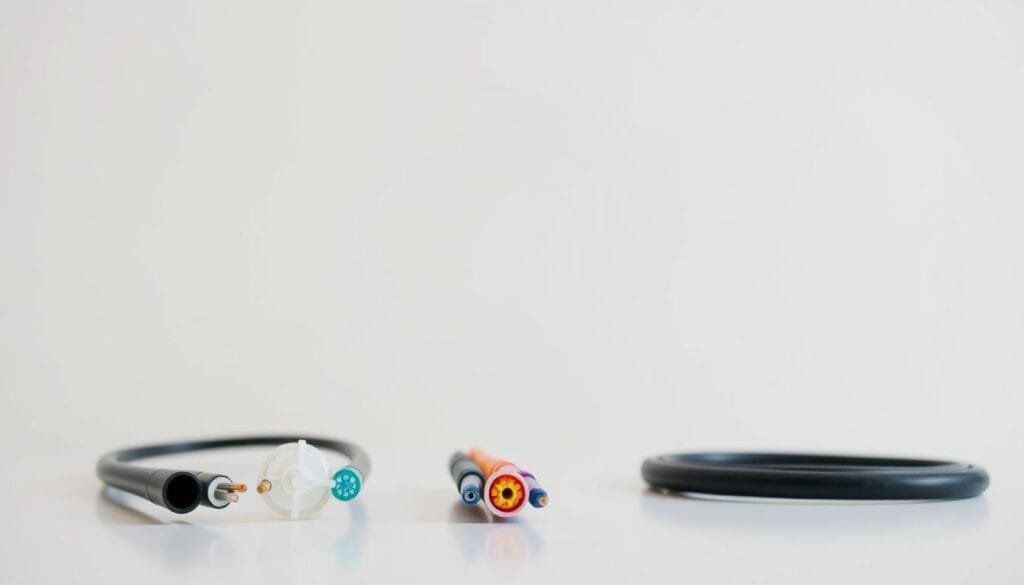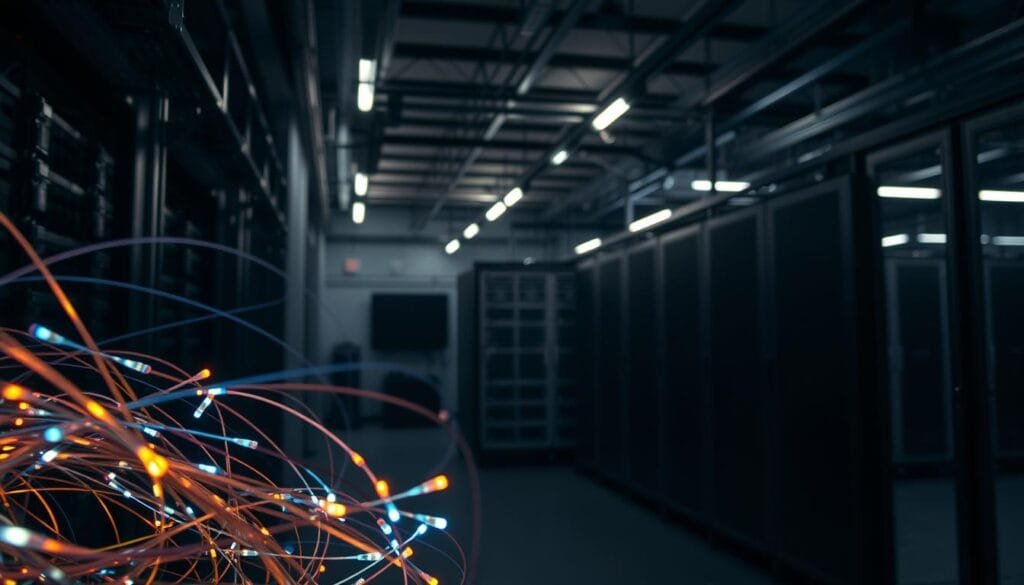Currently Empty: RM0.00
Ever wondered why some networks perform better than others? The secret often lies in the cable—specifically, fiber optics. With faster speeds, immunity to electromagnetic interference, and longer transmission distances, fiber optics revolutionize connectivity. Whether for home or business, selecting the best option ensures seamless performance.
Wellness Concept, Malaysia’s trusted provider, offers expert guidance. Their team helps clients navigate factors like distance requirements, speed needs, and connector types. Available seven days a week—including weekends—they provide personalized support via WhatsApp at +60123822655.
Key Takeaways
- Fiber optics deliver unmatched speed and reliability.
- They resist interference and work over long distances.
- Wellness Concept provides tailored solutions in Malaysia.
- Extended support hours include weekends (10 AM–5 PM).
- Contact them via WhatsApp for quick assistance.
Introduction to Fiber Optic Cables
Light pulses traveling at incredible speeds power today’s digital communication. Fiber optic cables form the backbone of modern networks, enabling rapid data transfer across continents. Unlike copper wires, they resist interference and deliver crystal-clear signals.
These cables use two primary materials: glass and plastic. Glass fibers offer higher purity and lower signal loss, ideal for long-distance transmission. Plastic variants are cost-effective for short-range applications, like home networks.
At the core of their functionality is Total Internal Reflection (TIR). Light pulses bounce along the cable’s interior, maintaining intensity over miles. This physics phenomenon ensures minimal degradation, even at two-thirds the speed of light.
For extended distances, signal amplifiers boost light pulses, preserving data integrity. This makes fiber optic cable systems perfect for undersea links and rural connectivity.
Malaysia’s telecom sector increasingly adopts this technology. Urban centers and emerging regions alike benefit from faster, more reliable signals. The shift reflects global trends toward future-proof infrastructure.
- Glass vs. Plastic: Glass for long-haul, plastic for affordability.
- TIR: Keeps light pulses intact over vast distances.
- Amplifiers: Essential for cross-country networks.
- Malaysia’s Growth: Rising demand for high-speed solutions.
Understanding Fiber Optic Cable Basics
Modern connectivity relies on thin strands of glass or plastic, thinner than a human hair. These optic cables transmit data as light pulses, revolutionizing speed and reliability. Their design ensures minimal interference, even in high-demand environments.
Breaking Down Cable Layers
Every optic cable has four key layers:
- Core: The central pathway for light (8.3–62.5µm thick).
- Cladding: Reflects light back into the core, preventing leaks.
- Coating: Protects against physical damage.
- Jacket: Outer shield for environmental resistance.
Singlemode vs. Multimode Light Propagation
Light travels differently based on cable type:
| Feature | Singlemode (SMF) | Multimode (MMF) |
|---|---|---|
| Core Size | 8.3–9µm | 50–62.5µm |
| Distance | Up to 100km | ≤2km |
| Use Case | Long-haul telecom | Data centers, LANs |
Singlemode lasers are powerful—never look directly into live connectors. Safety goggles are recommended during installations.
Attenuation and Material Choices
Fiber loses just 3% of its signal over distance, while copper sheds 94%. Glass fibers excel in purity, while plastic suits budget-friendly, short-range setups.
Types of Fiber Optic Cables
Not all fiber optic cables are created equal—each type serves distinct connectivity purposes. From long-haul telecom to data center setups, selecting the right one ensures efficiency and cost-effectiveness.

Single-Mode Fiber (SMF)
Single mode cables use a narrow core (8.3–9µm) and laser light at *1310–1550nm wavelengths*. Ideal for distances up to 100km, they power telecom backbones and cross-campus links. Their precision minimizes signal loss, making them perfect for Malaysia’s expanding infrastructure.
Multimode Fiber (MMF)
Multimode fiber features a wider core (50–62.5µm), allowing multiple light paths. It supports shorter distances (under 2km) but excels in data centers and CCTV systems. MMF balances performance and affordability for localized networks.
Other Fiber Types (OM1, OM2, OM3, OM4, OS2)
Specialized variants cater to niche needs:
| Type | Max Distance | Use Case |
|---|---|---|
| OM1 | 300m | Legacy LANs |
| OM4 | 1,100m | High-speed data centers |
| OS2 | 200km+ | Hyperscale networks |
In Malaysia, multimode fiber (OM3/OM4) suits urban deployments, while OS2 connects remote regions. Wellness Concept tailors solutions based on budget and technical demands.
Key Factors to Consider When Choosing Fiber Optic Cable
Network performance hinges on understanding critical fiber optic specifications. Whether upgrading a data center or deploying in a high-rise, three factors dominate: transmission distance, network speed, and safety compliance.
Distance Requirements
Longer distance demands single-mode fiber (SMF), which spans up to 100km with minimal signal loss. For under 2km, multimode (OM3/OM4) offers cost-effective performance. Pro tip: Use online calculators to match OM4’s 550m limit for 10GbE networks.
Network Speed and Bandwidth
Network speed needs vary: 4K video streaming requires 25Mbps, while cloud backups may need 1Gbps. Future-proof with OM5 or 400G-ready cables. A Kuala Lumpur data center boosted performance by 300% after upgrading to 40GbE Active Optical Cables (AOC).
Cable Jacket and Fire Ratings
Malaysian high-rises mandate OFNP (plenum-rated) jackets for air-handling spaces, per NEC Article 77. OFNR (riser-rated) suits vertical runs. Fire safety isn’t optional—non-compliant installations risk penalties and downtime.
“Investing in future-ready fiber reduces upgrade costs by 40% over five years.”
- Distance: SMF for cross-country, MMF for local networks.
- Speed: Match bandwidth to application demands.
- Safety: OFNP/OFNR jackets ensure compliance.
Fiber Optic Connectors and Modules
Connectors and modules form the backbone of any fiber optic setup. They ensure seamless light transmission between cables and equipment, minimizing signal loss. In Malaysia’s fast-growing digital landscape, selecting the right components boosts network reliability.
Common Connector Types
Different connectors serve unique purposes:
- LC: Dominates Malaysian data centers for its compact size and push-pull latch.
- SC: Features a snap-in design, ideal for telecom and CATV systems.
- ST: Uses a bayonet twist lock, common in older installations.
- MTP/MPO: Supports 12–24 fibers, crucial for 400G Ethernet.
| Connector | Size | Best For |
|---|---|---|
| LC | 1.25mm | High-density setups |
| SC | 2.5mm | Broadband networks |
| MTP-12 | Multi-fiber | Data center trunks |
Transceiver Modules Explained
Hot-swappable modules like SFP and QSFP adapt networks to evolving needs. SFP28 delivers 28Gbps, while QSFP28 handles 100Gbps. Always check backward compatibility—older ports may not support new modules.
“MPO-24 configurations future-proof networks for hyperscale demands.”
For cost-sensitive projects, SFP+ offers 10Gbps at half the price of QSFP28. Wellness Concept recommends auditing existing equipment before upgrades.
Applications of Fiber Optic Cables
From streaming high-definition content to securing smart cities, fiber optics power modern connectivity. These cables support diverse applications, enabling faster, more reliable systems across industries. Whether for global telecom networks or local surveillance, their versatility is unmatched.

Telecommunications and Data Centers
Fiber optics are the backbone of Malaysia’s 5G rollout, delivering low-latency connections nationwide. In data centers, OM4 multimode cables handle 40Gbps speeds, while OS2 single-mode links hyperscale facilities. A Kuala Lumpur hospital upgraded to fiber, reducing MRI image transfer times by 70%.
FTTH (Fiber-to-the-Home) deployments now cover 85% of urban areas, offering 1Gbps plans. Mode conditioning patch cords ensure seamless compatibility between legacy and modern systems.
AV and Surveillance Systems
Stadiums like Bukit Jalil use fiber for 4K60 HDMI signals, transmitting 18Gbps without lag. Smart city projects rely on fiber-optic surveillance networks, with Petronas Towers’ infrastructure serving as a benchmark.
- 5G Backhaul: Fiber connects towers to core networks, enabling nationwide coverage.
- Medical Imaging: Instantaneous data transfer improves diagnostic accuracy.
- Public Safety: High-resolution cameras feed real-time footage to command centers.
These applications showcase fiber’s role in building Malaysia’s digital future.
Advantages of Fiber Optic Over Copper Cables
Businesses upgrading their infrastructure face a clear difference between copper and fiber. Fiber optics deliver 100Gbps speeds—2.5x faster than copper’s 40Gbps limit. They also lose just 3% of signal over distance versus copper’s 94% attenuation.
- EMI Resistance: Perfect for Malaysia’s industrial parks where electromagnetic interference disrupts copper lines.
- Enhanced Security: Banking networks use fiber because it doesn’t radiate signals that hackers can intercept.
- Cooler Operations: Data centers save 30% on HVAC costs since fiber generates less heat than copper.
The table below shows long-term cost advantages:
| Factor | Fiber Optic | Copper |
|---|---|---|
| 5-Year TCO | $12,000 | $18,500 |
| Upgrade Cycle | 10+ years | 5-7 years |
| Downtime Costs | 42% lower | Higher maintenance |
Fiber also supports sustainable operations. Its glass components are 100% recyclable, unlike copper’s mining impact. For data transmission that’s faster, safer, and greener, fiber outperforms in every category.
“Malaysian factories reduced network failures by 76% after switching to fiber optics.”
From industrial automation to financial transactions, these advantages explain why 83% of new Malaysian installations now use fiber. The technology simply delivers better data transmission with lower lifetime costs.
Wellness Concept: Your Partner in Fiber Optic Solutions
Reliable connectivity starts with trusted expertise in fiber optic solutions. In Malaysia’s fast-evolving digital landscape, Wellness Concept delivers tailored network infrastructure support. Their team bridges the gap between technical requirements and practical implementations.
About Wellness Concept
With 15 years serving ASEAN markets, Wellness Concept brings proven management of complex installations. They specialize in custom cable fabrication and on-site termination services. Their bilingual support team handles everything from design to troubleshooting.
Clients benefit from:
- Precision testing with OTDR equipment
- Compliance with Malaysian telecom standards
- Future-proof infrastructure planning
Business Hours and Contact Information
The Kuala Lumpur office welcomes walk-ins Monday-Friday (9:30 AM–6:30 PM). For urgent weekend needs, emergency support is available via WhatsApp at +60123822655 (10 AM–5 PM).
Wellness Concept simplifies fiber optic deployments. Their end-to-end approach ensures networks perform at peak capacity from day one.
Conclusion
Selecting the best fiber optic cables depends on distance, speed, and safety needs. Single-mode suits long-range telecom, while multimode works for local networks. Proper connectors and fire-rated jackets ensure reliable performance.
Consulting experts like Wellness Concept simplifies decisions. Their team evaluates network needs and recommends future-ready solutions. Emerging tech like 800G OSFP promises even faster speeds soon.
For personalized advice, contact them via WhatsApp at +60123822655. They offer site surveys to match infrastructure with growing demands. Explore more about optimizing connectivity in their fiber solutions guide.
FAQ
What is the difference between single-mode and multimode fiber?
Single-mode fiber (SMF) transmits data over long distances with minimal signal loss, using a smaller core. Multimode fiber (MMF) supports shorter distances but allows multiple light modes, making it ideal for high-speed networks.
Which fiber optic cable is best for high-speed data centers?
OM4 and OS2 cables offer superior bandwidth and low latency, making them perfect for data centers requiring fast, reliable transmission.
How does fiber optic cable improve network performance?
Fiber optics provide higher bandwidth, faster speeds, and lower signal loss compared to copper cables, ensuring efficient data transmission with minimal interference.
What are common fiber optic connector types?
LC, SC, ST, and MTP/MPO connectors are widely used. LC is compact for high-density setups, while MTP/MPO supports multi-fiber connections in data centers.
Can fiber optic cables be used for security systems?
Yes, fiber optics deliver high-quality video signals over long distances, making them ideal for surveillance and AV applications.
Why choose fiber over copper for long-distance networks?
Fiber optic cables experience less signal degradation, support higher speeds, and resist electromagnetic interference, making them superior for extended distances.
What factors affect fiber optic cable selection?
Distance, bandwidth needs, environmental conditions, and fire safety ratings are key considerations when selecting the right cable.
How does Wellness Concept support fiber optic solutions?
Wellness Concept provides expert guidance, quality products, and reliable support to help businesses optimize their fiber optic infrastructure.



